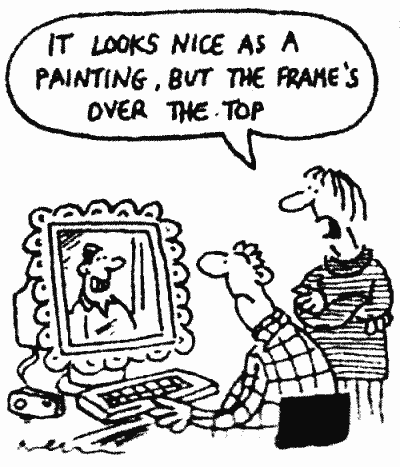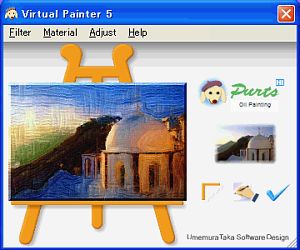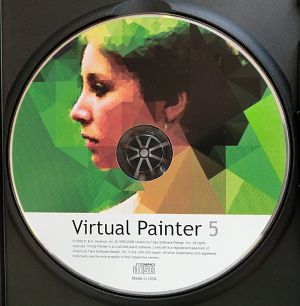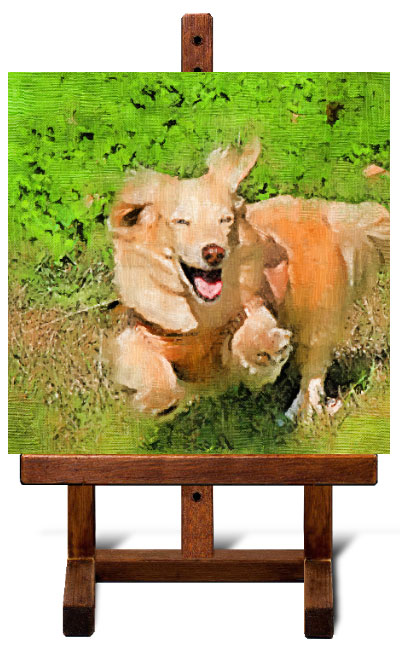Illustration of the VP introduction article in the SundayTimes, UK, January 25, 2004.
Automatically making a painting from a photograph
Virtual Painter 5
2006, distributed by P&A America

Loux - VP's icon model

Sleeping painter - VP6 icon
Virtual Painter - The Mechanism of Painting
In the past, TVs were vacuum tube type.
Have you ever looked into the back of one of these devices?
There was a magnificent city of light with skyscrapers.
It's a very complex circuit, but it's not a trick or magic.
Virtual Painter is a program that turns a photo into a painting, but by an algorithm based on the mechanism of painting, not tricks or magic as well.
You can see examples of each virtual painter's work on the following detailed pages, but few people would immediately imagine the mechanism behind the scenes when looking at them.
This exhibition is structured to inductively reveal the aesthetic principles behind the project while recounting it.
I hope that when you finish reading this exhibition, you will understand why virtual painters paint the way they do.
What is Virtual Painter?
"Virtual Painter (VP) is a software that creates digital paintings based on photographs supplied by you.
There is no need for you to "paint" the pictures - that's the job of the "virtual painters" (filters).
All you have to do is supply them with the materials and then set them to work.
You will be surprised how easy it is to get VP to create very realistic paintings.
But the resulting pictures, based on your materials, are all originals.
These unique paintings come about as a result of the interaction between your photographs and the VP filters.
VP is not a painting tool that you must master to create your own works of art.
Rather, the filters it offers are like agents, virtual artists who have their own characteristic techniques and methods.
You can preview their art and even request a few changes, but you can leave the hard work to them.
Sit back and watch them paint. You're sure to be pleasantly surprised, time after time.
Happy virtual painting !"
(From the VP5 Users' Manual)
History
In 1995, Virtual Painter opened for the public on Compuserve and Niftyserve for Win3.1.
Original "painters" were Rabica (watercolor), Purts (oils), Quapeo (gouache), and Targelin (triangles). In 1996,
VP2 was released as shareware. Plince (colored pencils) and Saplet (pastels) were added. When a CD package went on sale in 1997,
there were seven painter styles supported. With the release of VP4 in 2003, there were sixteen.
In 2005, VP5 was greatly enhanced to support the high-resolution of digital cameras.
In 2010, a joint development program with Casio Computer Co., Ltd. was launched.(was ended in April 2014.)
2014. Released Virtual Painter 6 (English, Japanese, Win8.1 store app editions) and VirtualPainter for iOS
2010. Joint development program with Casio Computer Co., Ltd. was ended in April 2014.
2006. Released Virtual Painter 5 (distributed by P&A America. Inc.).
2004. Won Shareware Industry Conference 2004 People's Choice Award.
2003. Released Virtual Painter 4 English and Japanese version (distributed by P&A America. Inc.).
2001. Released Virtual Painter 3 English version (distributed by Jasc Software, Inc.).
2000. Released Virtual Painter 3 (distributed by P&A., Inc.).
1999. Released Virtual Painter 2 (distributed by P&A., Inc.).
1997. Released Estampes French Virtual Painter (distributed by WSKA).
1997. CD-ROM package release (distributed by P&A., Inc.).
1997. Won 5th Online Software Prize.
1996. Released VP2 (shareware).
1995. Released Virtual Painter online via Compuserve and Niftyserve.





